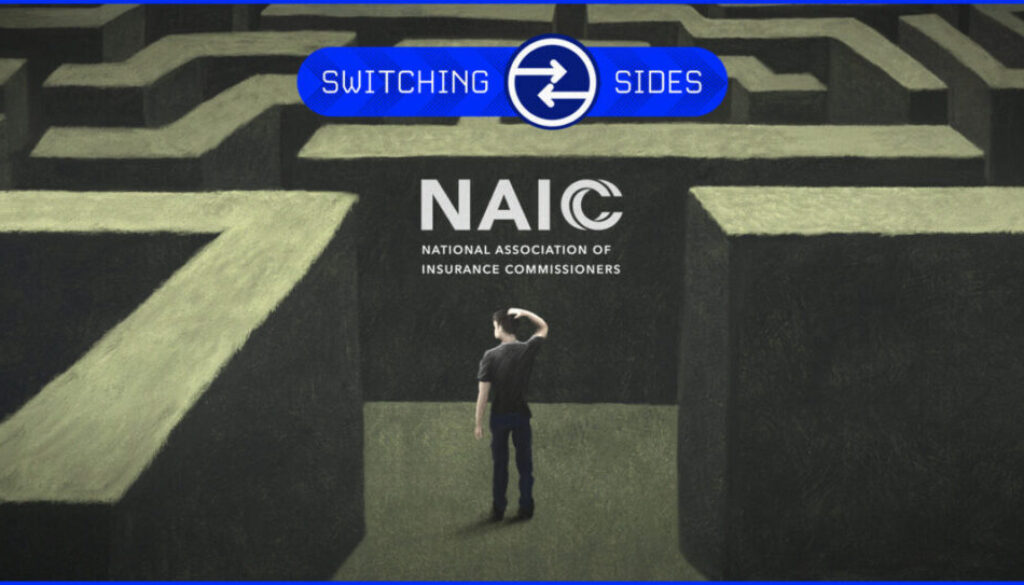Switching Sides: Advocates say NAIC effort on AI ‘devoid of any guidance’

Editor’s Note: This is the second article in an ongoing, occasional series that will look at the movement of insurance commissioners and other regulatory officials into plum corporate roles or lobbying posts after leaving their regulatory positions. The first article can be found here.
Views on artificial intelligence in the insurance industry differ depending on who is doing the talking.
Insurance executives see the potential to cut risk, sharpen underwriting, and perform quicker customer service with fewer people – all of which adds up to a better report to investors. Consumer groups see the potential for hidden discrimination against classes that already suffer from rampant bias.
So, when it came time for the National Association of Insurance Commissioners to regulate the rapidly growing use of AI in insurance, both sides lobbied fiercely.
The resulting Model Bulletin on the Use of Artificial Intelligence Systems by Insurers is acceptable to the industry, but a bitter disappointment for consumer groups. Some critics use the AI experience as an example of how the industry regularly manipulates regulators to get the rules it wants.
Advocacy organizations, academics, and law firms have detailed how a “revolving door between the insurance industry and regulators creates a dangerous cycle that undermines consumer protections, threatens the objectivity and strength of regulatory oversight, and tilts policy toward corporate interests,” Public Citizen said.
Public Citizen members picketed the NAIC summer meeting in Minneapolis and attempted to get regulators to sign an anti-corruption pledge. The group collected zero signatures.
Lengthy effort
In December 2023, the NAIC Executive Committee and Plenary adopted the AI bulletin. More than three years earlier, in August 2020, the NAIC adopted a promising set of AI principles created by its Artificial Intelligence Working Group.
Among other things, the principles called on insurers take proactive steps to avoid proxy discrimination against protected classes, monitor the operation of its AI system and remediate harmful, unintended consequences.
The model bulletin makes no rules for insurance companies and does not address proxy discrimination. It has been adopted in some form by 24 states.
Then-Maryland insurance commissioner Kathleen Birrane chaired the NAIC Innovation, Cybersecurity, and Technology Committee. Her current DLA Piper law firm biography identifies her as “the primary author” of the AI model bulletin.
When discussions got serious, regulators had to get real, Birrane said in a recent interview.
“The practical reality is that we were not going to get a bulletin that would be that would be adopted if we tackled areas like proxy discrimination and those hot-button issues,” she said. “That’s because there is a fundamental disagreement among regulators as to that concept. So, what we did was we developed a document that was a consensus document that would allow us to address a framework.”
The bulletin, Birrane stressed, is “not the last word, just the next word.”
Nearly two years after the AI bulletin was adopted, NAIC regulators are still pondering the next step. The Big Data and Artificial Intelligence Working Group met in late-September, with Colorado Insurance Commissioner Michael Conway saying it is “vitally important for us to be moving forward with some action … as it relates to model laws or model regulations in the AI space.”
But Iowa Insurance Commissioner Doug Ommen cautioned that it would be “premature” to move on to tougher AI regulations just yet.
“[T]hat work we’ve done with the bulletin is really primarily grounded in the principles of governance, and along with this evaluation tool, really are putting us as regulators in a good place to look at our own industries and better understand what it is that they’re doing,” Ommen said. “Because that’s going to be needed to inform our decisions.”
Disappointed advocate
Birny Birnbaum is executive director of the Center for Economic Justice. He pushed hardest for some type of AI regulation that addressed proxy discrimination – defined as the use of a neutral factor as a stand-in for a protected characteristic – such as race, gender, or age – in a way that leads to discriminatory outcome.
Addressing proxy discrimination should be easy, Birnbaum said, because it represents both types of unfair discrimination in insurance: the actuarial basis and the protected class basis.
For example, if an insurer used criminal history or consumer credit in pricing or underwriting, the apparent relationship of those data to claims may be proxy discrimination or disparate impact. With disparate impact, the data have some relationship to the insurance outcome, but, because of actual historical discrimination against the protected class, the data can perpetuate those disproportionate outcomes.
Birnbaum recalled Birrane’s candid assessment that tackling proxy discrimination would have killed any effort to address emerging AI technology. But the NAIC’s lack of progress on developing meaningful consumer protections and insurer guidance on AI rests with Birrane, he added.
“She used her position to stop or bring to a crawl on virtually every front,” Birnbaum said. “When the NAIC did produce a work product – like the model bulletin – it was devoid of any actual guidance. The key message in the model bulletin to insurers is ‘obey the law.’ It’s hard to see why it took years for the NAIC to develop so-called guidance that tells insurers what they already know but fails to tell them how to do it.”
Birnbaum noted that Birrane went from DLA Piper to four years as commissioner and back to DLA Piper, where she is a partner and “serves as the firm’s U.S. Insurance Regulatory Practice leader.”
And the NAIC still hasn’t addressed proxy discrimination in insurers’ use of big data or AI, Birnbaum noted.
An important objective at the time was to “put a stake in the ground,” Birrane explained, and show the industry and the federal government that state regulators were on top of AI. She has frequently said that the bulletin is not the end.
“There are next logical steps about having the NAIC develop a more granular regulatory framework,” she said. “So, having the bulletin go out at the next level of enforcement. They did some of that … with respect to accelerated underwriting last year, in providing a bit more detail about what responsible program looks like.”
‘I already had a great practice’
Otherwise, Birrane dismisses critics who cite her as an example of a commissioner cozying up to industry. She was appointed by Republican Gov. Larry Hogan in May 2020 and asked to stay on by Democratic Gov. Wes Moore after he took office in January 2023.
“I stayed two years longer than I had been planning to … because I felt really passionate about the work we were doing,” Birrane said.
Her father, Edward J. Birrane Jr., was Maryland’s insurance commissioner from 1976 to 1982. Kathleen Birrane previously served as counsel for the insurance department and had a familiarity with insurance regulation.
“I didn’t go to become the insurance commissioner because I was looking for a gig that would enhance my practice,” she said. “I already had a great practice.”
The NAIC does have a conflict-of-interest policy, but it is silent on regulators leaving public service to immediately lobby their former colleagues. Repeated attempts to speak with NAIC President Jon Godfread, North Dakota insurance commissioner, about the Public Citizen protest and conflict-of-interest issues were unsuccessful.
The NAIC sent this statement instead:
“Every state insurance regulator operates under the ethical and constitutional statutes established by the state in which they serve. In addition, as a member organization, the NAIC has a longstanding conflict of interest policy that applies to the organization, its events, and activities. This framework ensures that regulators, whether elected or appointed, are subject not only to the governing laws of their respective states, but also to the commitment of the NAIC to uphold the highest standards of transparency and integrity.”
© Entire contents copyright 2025 by InsuranceNewsNet.com Inc. All rights reserved. No part of this article may be reprinted without the expressed written consent from InsuranceNewsNet.com.
The post Switching Sides: Advocates say NAIC effort on AI ‘devoid of any guidance’ appeared first on Insurance News | InsuranceNewsNet.






